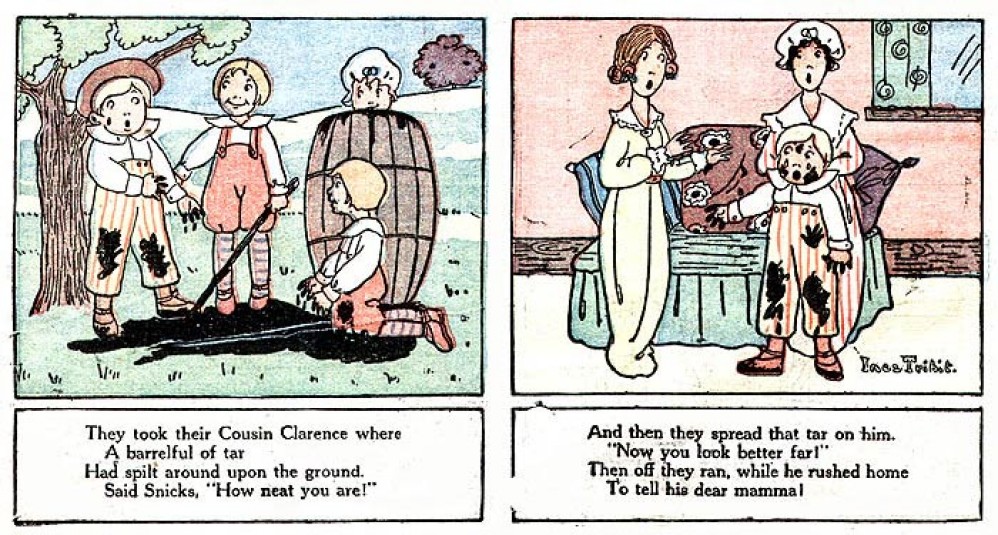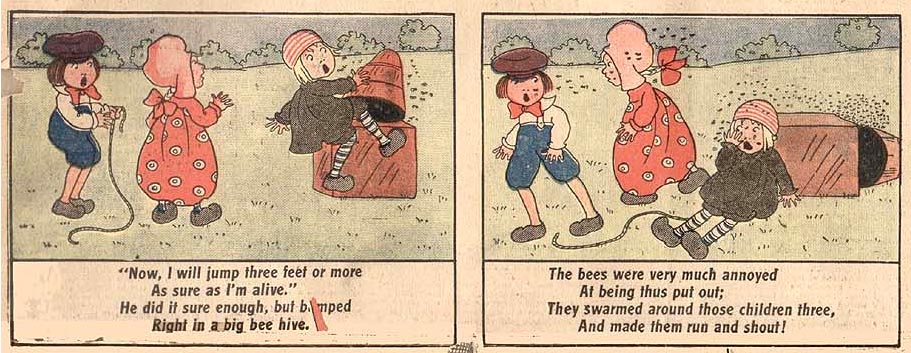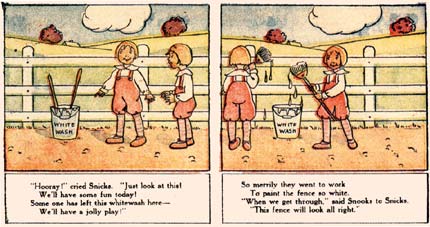Inez Townsend, also known as Inez Tribit, was an early 20th-century British-American newspaper comic artist, illustrator and singer-songwriter. She created two text comics, 'Gretchen Gratz' (1904-1905) and 'Snooks and Snicks' (1913-1915), both gag comics about stereotypical Dutch children, set to rhyme. Historically, Mrs. Townsend is important as one of the earliest British and U.S. female comic artists.
Personal life
Inez Towsend was born in 1877 in England and immigrated to the United States in 1891. While working as a clerk in a tea store in 1903, she debuted as an illustrator and cartoonist for the Philadelphia Inquirer. In 1904, she provided artwork for the Los Angeles Times. Townsend married a newspaper reporter, William E. Tribit, in 1905, with whom she had a daughter. Later in life, she became first secretary of the Los Angeles League of American Pen Women and was a member of the Southern California Women's Press Club too. Her personally written and illustrated novels, 'Indignant' (1916) and 'The High Cost of Living' (1917), were serialized in the children's magazine St. Nicholas. Townsend also co-wrote a song, 'Way Back Home' (1917) with Hallie M. Swartz, and another song on her own: 'What the Boy Said' (1921).
Gretchen Gratz
Between 31 January 1904 and 8 January 1905, Townsend's comic strip 'Gretchen Gratz' ran in the Philadelphia Inquirer. Obviously inspired by the success of Rudolph Dirks' 'The Katzenjammer Kids', the series also featured naughty, stereotypically portrayed European children. In fact, the title characters Hans and Fritz from Dirks' comic were basically ripped off under the names 'Hans and Claus' in Townsend's series. Yet she still managed to give her comic strip a more personal touch. The actual main character is a girl, Gretchen Gratz, and most of the gags center around the three of them doing something naughty or stupid. Another major difference was the format. While 'The Katzenjammer Kids' was a balloon comic, 'Gretchen Gratz' is still a text comic with rhyming dialogue beneath the images, as was common at the time. All storylines are set in a stereotypical version of the Netherlands, complete with cows, windmills, tulip fields and lots of water. Hans, Claus and Gretchen walk on clogs. It's obvious that Mrs. Townsend never visited the country in her entire life and didn't know much about it either. While Hans is a common name in the Netherlands, Claus is far more common in Germany. Similarly, Gretchen's name is a mispronunciation of the Dutch girls' name 'Greetje'. Interestingly enough, the children speak perfect English as opposed to the mangled German-English in 'The Katzenjammer Kids'.
Snooks and Snicks, the Mischievous Twins
Mrs. Townsend had another text comic a decade later, 'Snooks and Snicks, the Mischievous Twins', which ran in the Philadelphia Inquirer from 23 February 1913 until 4 July 1915. While it enjoyed a longer run it wasn't much more original than its predecessor. Once again it was set in the Netherlands and starred two mischievous boys, Snooks and Snicks, and a girl. The series later introduced another recurring cast member, cousin Clarence, whose naïvité made him the perfect victim for Snooks and Snicks' shenanigans.
Death
After her husband's death in 1928, Mrs. Townsend and her daughter lived in Los Angeles for the remaining decades. She passed away in 1960.
'Snooks and Snicks, the Mischievous Twins'.





